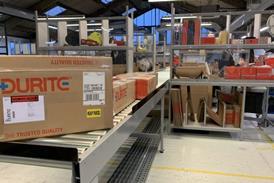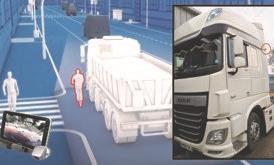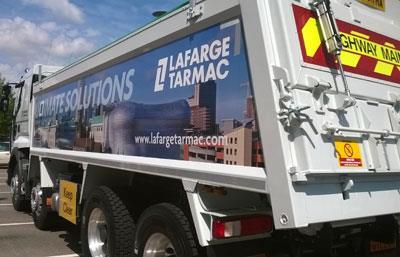
Eyebrows rose in some parts of the industry when construction materials supplier Lafarge Tarmac announced it was going to start accrediting subcontractors for Fors as part of a new safety drive. But as the programme gathers pace, the firm has no regrets.
There are many different approaches to managing subcontractors, but the announcement back in March by construction materials giant Lafarge Tarmac that it was going to start auditing its core subbies for compliance with Transport for London (TfL)'s Fleet Operator Recognition Scheme (Fors) was an industry first.
Shortly after, the firm became the first UK LGV fleet operator to be approved to undertake whole fleet Fors accreditation, beginning a process that will see it accredit the 700-plus firms and 1,450 vehicles in its core Lafarge Tarmac-liveried subcontractor fleet to the Fors Bronze standard.
The move is part of a drive to raise safety levels across the whole Lafarge Tarmac transport operation, which also includes its own 250 strong fleet of trucks and a further 1,300 or so spot hire subbie vehicles - no mean feat when you've got 330 sites of your own to manage and are busy shifting 70m tonnes of material each year by road plus another 9m tonnes by rail.
Lafarge Tarmac has some form in this area, however: since mid-2012, the company has been ensuring all its own new vehicles and those being acquired new by its core subbies are kitted out to the level now specified by the Work Related Road Risk (WRRR) standard developed by the Construction Logistics Cyclist Safety (Clocs) working group.
Risks
This includes side underrun bars for otherwise exempted vehicles, nearside and front proximity sensors, audible left turn warning systems, and signage to warn vulnerable road users such as cyclists of the risks around moving trucks.
More recently, Lafarge Tarmac has also begun a retrofit scheme to bring existing vehicles up to eight years old – both its own and those of its core subbies – up to the same standard, a move national transport manager Sean McGrae (pictured), who contributes to the Clocs working group, says “will cover the majority of the fleet”.

Impressively, the firm is bankrolling this retrofit for its core subbies. Thanks to falling technology prices, the cost per vehicle is around £1,200, says McGrae – roughly half the cost involved when the firm first started work on the plan.
That's still not exactly cheap, of course, but Lafarge Tarmac CEO Cyrille Ragoucy signed it off without quibble, he reports. “There was no question or challenge when we asked for the money, once we outlined why we thought it was needed,” McGrae confirms.
And the move to pay for the upgrade was a calculated one, of course. “Some [subcontractor] firms would spend that money on their vehicles; others would not. But they'll happily let us do it,” says McGrae. “And the reality is that ultimately, the success of our contract hauliers as independent businesses is important to us. If we start putting more costs their way and pushing them over the edge and they go out of business, that's no good to us.
“We also believe we need a quick rollout of this and we don't want to stall it because we're arguing with hauliers about whether they should or should not fit the kit,” he continues. “We'd either lose them as hauliers, or we'd have to put their rate up and we'd effectively end up paying for it anyway. Besides that, we have a very strong commitment to safety and this obviously fits into that.”
Retrofit
The retrofit programme on vehicles up to eight years old will involve around 1,100 trucks and is scheduled for completion by early 2015, he says. Trucks operating in “obvious cyclist areas” like Manchester, Birmingham, Oxford and Cambridge will be addressed first, he continues – London being “pretty much done already”.
Moving on to the plans for subbie Fors accreditation, McGrae says the decision took precedence over Lafarge's efforts to improve on its own Bronze standard accreditation. “We're working towards Silver and Gold accreditation but to be honest, our focus is on a broad brush. It'd be all well and good for us to say we're Gold for our 250 vehicles, but we operate nearly 3,000 so it wouldn't have the same impact in terms of safety out on the road. We'll do the work on Silver and Gold, but it's about making sure we really have an impact and by affecting our direct liveried fleet of 1,700, we'll make a really big impact very quickly,” he explains.
Like the safety kit rollout, Lafarge Tarmac is essentially bankrolling the Fors accreditation process, having taken on around 30 trained auditors on a full-time basis in the last six months with potentially another 20 or so on the way.
Any vehicle, driver training or management process improvements required for successful Fors accreditation will need to be paid for by individual subcontractors, admits McGrae – but since the WRRR standard's safety kit specification Lafarge Tarmac is already financing exceeds the cycling safety equipment standards called for by the Fors Bronze standard, that shouldn't leave them too exposed.
As Lafarge Tarmac has a history of auditing its sub-contractors twice a year anyway, adds McGrae, standards of driver training and fleet management, too, are already good at many subcontractors – though Fors may bring a greater focus on the safety culture, he concedes.
Not a soft standard
So far, over 25% of core subcontractor drivers have been Fors accredited, a figure that should rise to 60% by the end of this year and to 100% in early 2015 – though there have been some, admits McGrae, who have not met the required standard despite Lafarge Tarmac’s encouragement.
“Not all of them pass,” he confirms. “It would be too soft a standard if they did. We've had a few failures that we've not been able to resolve, but with most of them, we're able to go back after some time and any issue has been resolved.”
Most subcontractors have reacted very positively to the initiative, he adds – not least as Fors accreditation covers the whole company, not just the bits of it doing work for Lafarge Tarmac, which can help them pitch successfully for work elsewhere. “In that sense, we're doing them a favour,” agrees McGrae. “Yes, a number of them will have vehicles working with our competitors too, but the bottom line is that we can't pick and choose and say we're not doing some because it might help our competitors.
“Our message isn't about that – it's about trying to raise our safety standards,” he adds.
Lafarge Tarmac isn't currently including the wider spot hire subcontractor fleet in either the safety kit retrofit or the Fors accreditation programme – as McGrae points out, “we can't fix the whole industry!”.
But it is looking at ways to encourage all its subbies into both, he says. “Ultimately, we'll be looking for any operator working for us to be Fors accredited and fitted out with that safety equipment,” he confirms.
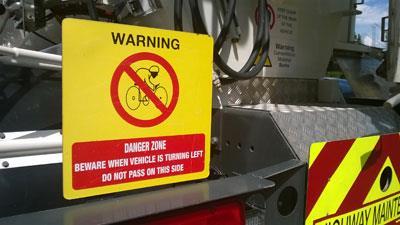
Support for a broader Fors
Lafarge Tarmac isn't just a fan of Fors in its present form – it also supports plans to extend the scheme outside London, even though TfL has indicated this will involve Fors being placed in the hands of a private organisation and some suspect it may also mean firms end up having to pay for membership (MT 28 April).
“It needs to be national – absolutely,” says McGrae. “The thing with the private ownership is that we don't really know what that looks like at the moment. But the principle, the key, is that we have a common standard everyone recognises and works to. That's the major driver for us.”
If paid-for membership were suddenly introduced, it would be unlikely to put Lafarge Tarmac off its current drive for sub-contractor accreditation, however. “We'd want to understand what that meant to our individual hauliers as much as for us. But it's got to be paid for in some way, and if we can support that at a sensible level that doesn't prove a problem for our hauliers, I think we would,” he confirms. “The key for us is a common standard – that's what we really want to push for.”
So given its experience of accrediting other firms so far, might Lafarge Tarmac itself be among those hoping to win the tender to run Fors? “No,” laughs McGrae. “I think we'll just concentrate on our core business.”
Sub-contractor dependence
Lafarge Tarmac's dependence on sub-contractors goes back many years and while it does still run a 250-strong fleet of its own, the use of third party vehicles is clearly central to the operation.
The firm also uses third party logistics companies in a limited way – McGrae cites cement tanker operations as one example – but finds old-fashioned subbies are generally a more attractive option.
“The great thing about using independent contract hauliers is the flexibility it gives us as a business,” he comments.
Third party logistics companies tend to want greater levels of commitment and longer-term agreements from their clients and also don't usually run the right kind of vehicles for a construction materials specialist like Lafarge Tarmac, he explains.
“A lot of the big 3PLs don't work in our sector at all, really,” he says. “Tipper and mixer operation is quite specialist and there aren't any big 3PLs in there.”
If a big 3PL was willing to run such vehicles and wanted to talk, it's something Lafarge Tarmac may look at in the future, he admits.
“But ultimately, we don't see it as a priority to switch, because actually, we get great service out of our independent contract hauliers and they're really supportive,” he says.

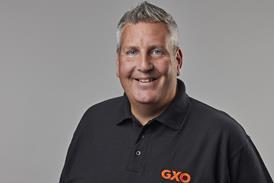

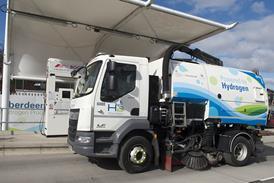


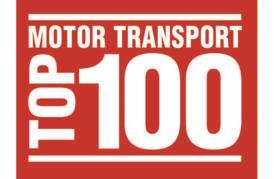
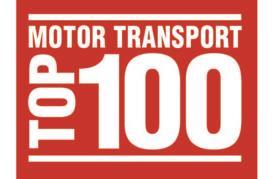
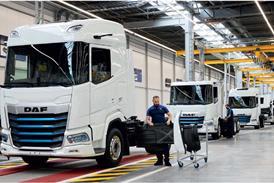
![Mercedes-Benz_eActros_600_(1)[1]](jpg/17820_mercedesbenz_eactros_600_11_978080.jpg)

